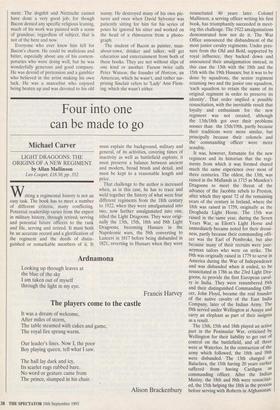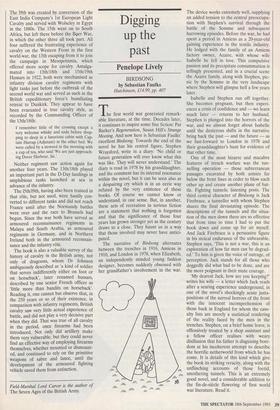Four into one can be made to go
Michael Carver
LIGHT DRAGOONS: THE ORIGINS OF A NEW REGIMENT by Allan Mallinson Leo Cooper, £18.50, pp. 352 Writing a regimental history is not an easy task. The book has to meet a number of different criteria, many conflicting. Potential readership varies from the expert in military history, through retired, serving and potential future officers to the rank and file, serving and retired. It must both be an accurate record and a glorification of the regiment and the deeds of distin- guished or remarkable members of it. It
must explain the background, military and general, of its activities, covering times of inactivity as well as battlefield exploits; it must preserve a balance between ancient and modern, broad brush and detail, and must be kept to a reasonable length and price.
That challenge to the author is increased when, as in this case, he has to trace and weld together the history of what were four different regiments from the 18th century to 1922, when they were amalgamated into two, now further amalgamated into one, titled the Light Dragoons. They were origi- nally the 13th, 15th, 18th and 19th Light Dragoons, becoming Hussars in the Napoleonic wars, the 19th converting to Lancers in 1817 before being disbanded in 1821, reverting to Hussars when they were resuscitated 40 years later. Colonel Mallinson, a serving officer writing his first book, has triumphantly succeeded in meet- ing this challenge. The 1922 amalgamations demonstrated how not do it. The War Office announced the disbandment of the most junior cavalry regiments. Under pres- sure from the Old and Bold, supported by royal influence, they backed down and announced their amalgamation instead, in this case the 13th with the 18th and the 15th with the 19th Hussars; but it was to be done by squadrons, the senior regiment retaining two and the junior one squadron, `each squadron to retain the name of its original regiment in order to preserve its identity'. That order implied a possible resuscitation, with the inevitable result that loyalty and enthusiasm for the new regiment was not created, although the 13th/18th got over their problems sooner than the 15th/19th, partly because their traditions . were more similar, but principally because their colonels and the commanding officer were more sensible.
It was, however, fortunate for the new regiment and its historian that the regi- ments from which it was formed shared much the same experience over most of three centuries. The oldest, the 13th, was raised in the Midlands in 1715 as Munden's Dragoons to meet the threat of the advance of the Jacobite rebels to Preston, after which they spent 72 of the remaining years of the century in Ireland, where the 18th was raised in 1759, originally as the Drogheda Light Horse. The 15th was raised in the .same year, during the Seven Years War, as Eliott's Light Horse and immediately became noted for their dressi- ness, partly because their commanding offi- cer was the Earl of Pembroke, but also because many of their recruits were jour- neyman tailors who were on strike. The 19th was originally raised in 1779 to serve in America during the War of Independence and was disbanded when it ended, to be resuscitated in 1786 as the 23rd Light Dra- goons, to provide the first European caval- ry in India. They were renumbered 19th and their distinguished Commanding Offi- cer, John Floyd, became the real founder of the native cavalry of the East India Company, later of the Indian Army. The 19th served under Wellington at Assaye and carry an elephant as part of their insignia as a result.
The 13th, 15th and 18th played an active part in the Peninsular War, criticised by Wellington for their liability to get out of control on the battlefield, and all three were at Waterloo. In the contraction of the army which followed, the 18th and 19th were disbanded. The 13th charged at Balaclava, the 15th having 20 years earlier suffered from having Cardigan as
commanding officer. After the Indian Mutiny, the 18th and 19th were resuscitat-
ed, the 15th helping the 18th in the process before serving with Roberts in Afghanistan. The 19th was created by conversion of the East India Company's 1st European Light Cavalry and served with Wolseley in Egypt in the 1880s. The 15th went on to South Africa, but left there before the Boer War, in which the other three all took part. All four suffered the frustrating experience of cavalry on the Western Front in the first world.war, the 13th escaping from it to join the campaign in Mesopotamia, which offered more scope for cavalry. Amalga- mated into 13th/18th and 15th/19th Hussars in 1922, both were mechanised as infantry division cavalry regiments with light tanks just before the outbreak of the second world war and served as such in the British expeditionary force's humiliating retreat to Dunkirk. They appear to have been evacuated in true cavalry style, as recorded by the Commanding Officer of the 13th/18th: I remember little of the crossing except a very welcome whisky and soda before drop- ping to sleep in a luxurious cabin with Cap- tain Harrap (Adjutant) in the other bed. We were called by a steward in the morning with a cup of tea, who said:'We are just approach- ing Dover Harbour, Sir.'.
Neither regiment saw action again for another four years. The 13th/18th played an important part in the D-Day landings in amphibious tanks launched at sea in advance of the infantry.
The 15th/19th, having also been trained in that role, but not used, were hastily con- verted to different tanks and did not reach France until after the Normandy battles were over and the race to Brussels had begun. Since the war both have served as armoured reconnaissance regiments in Malaya and South Arabia, as armoured regiments in Germany, and in Northern Ireland both in the armoured reconnais- sance and the infantry role.
The book is also a valuable survey of the history of cavalry in the British army, not only of dragoons, whom Dr Johnson ambiguously described as 'a kind of soldier that serves indifferently either on foot or on horseback', later renamed hussars, described by one senior French officer as `little more than bandits on horseback'. Reading it, one cannot but observe that, in the 250 years or so of their existence, in comparison with infantry regiments, British cavalry saw very little actual experience of battle, and did not play a very decisive part when they did. That was true of all cavalry in the period, once firearms had been introduced. Not only did artillery make them very vulnerable, but they could never find an effective way of employing firearms themselves, whether mounted or dismount- ed, and continued to rely on the primitive weapons of sabre and lance, until the development of the armoured fighting vehicle saved them from extinction.
Field-Marshal Lord Carver is the author of The Seven Ages of the British Army.



































































 Previous page
Previous page